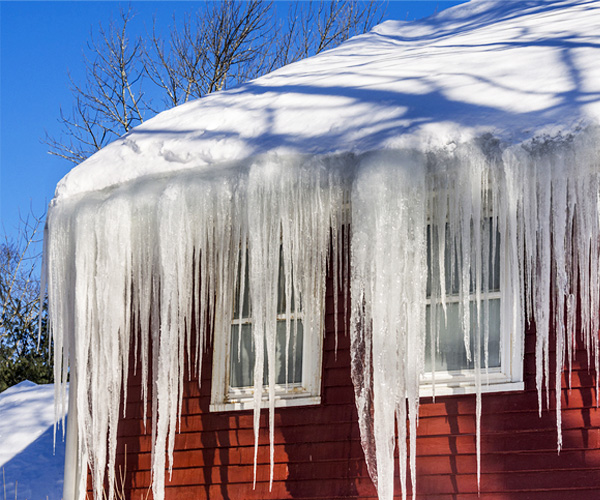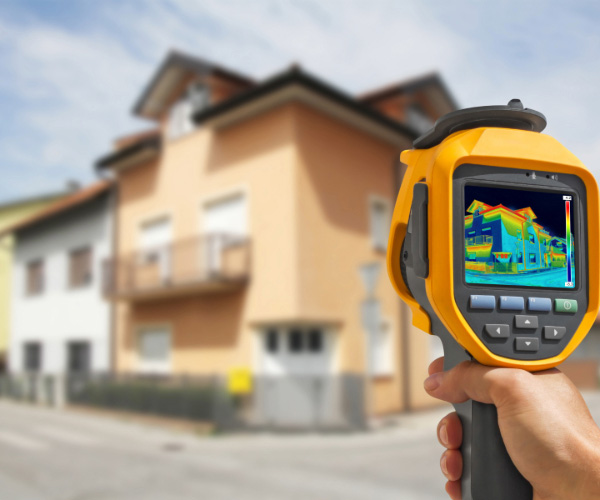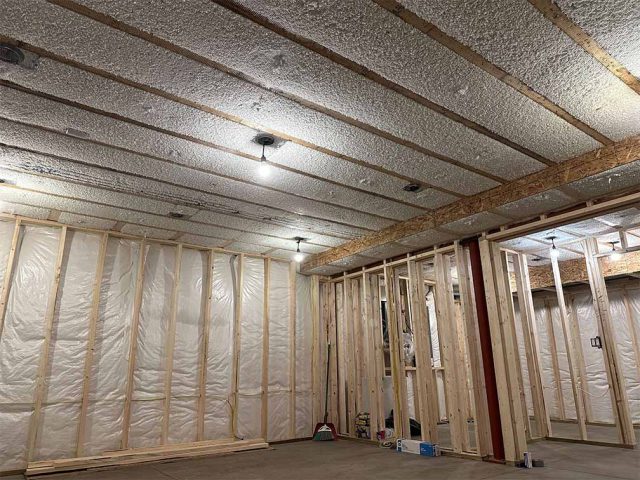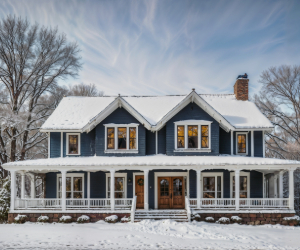Is It Time to Upgrade Your Home Insulation?
Living in Grand Rapids means dealing with freezing winters and warm, often muggy summers. That’s why home insulation plays such a critical role in keeping your house comfortable and your energy bills affordable. But insulation isn’t something you can just install and forget about. Over time, it can break down and lose its ability to keep your home protected.
Common problems like moisture, pests, and settling can wear down your insulation and reduce its effectiveness. Here’s what you need to know to keep your home insulation in top shape.
Moisture and Water Damage to Insulation
Ice Dams and Water Infiltration
 Ice dams are a major cause of water damage in Grand Rapids homes. They form when heat escapes from your attic, melting snow on the roof. That melted snow then refreezes at your roof’s eaves, creating a dam. As more snow melts, the water gets trapped and leaks into your attic, damaging insulation, ceilings, and even the roof itself.
Ice dams are a major cause of water damage in Grand Rapids homes. They form when heat escapes from your attic, melting snow on the roof. That melted snow then refreezes at your roof’s eaves, creating a dam. As more snow melts, the water gets trapped and leaks into your attic, damaging insulation, ceilings, and even the roof itself.
Impact of Moisture on Insulation
Moisture and insulation don’t mix. Wet or damp insulation can clump, compress, and lose its thermal resistance, becoming less effective at helping to prevent heat loss. Moisture can also lead to mold and mildew growth, making your attic smell musty and possibly causing health issues. If your insulation stays damp for too long, it can ruin your attic insulation and even rot wood.
Prevention and Detection
Preventing moisture damage starts with ensuring proper ventilation and using vapor barrier. Air sealing and insulation alongside ventilation to help prevent moisture build-up and mold. Watch for warning signs like water stains, mold, or a musty smell in your crawl space or attic. Be sure to solve any moisture problems before adding new insulation.
Pest Infestations and Insulation Damage
How Pests Damage Insulation
 Rodents and other pests are not nice houseguests. They love to nest in your attic or wall insulation. They chew through fire-resistant insulation and building materials, dig tunnels in loose-fill insulation, and contaminate areas with droppings and urine. As our weather cools each year, these unwelcome visitors often move indoors for warmth, making your insulation an easy target.
Rodents and other pests are not nice houseguests. They love to nest in your attic or wall insulation. They chew through fire-resistant insulation and building materials, dig tunnels in loose-fill insulation, and contaminate areas with droppings and urine. As our weather cools each year, these unwelcome visitors often move indoors for warmth, making your insulation an easy target.
Signs and Solutions
Signs of pest damage include torn fiberglass batts, tunnels in loose-fill insulation, nesting material, and unpleasant odors from their droppings and urine. If you notice these issues, it’s important to remove and replace the damaged insulation material. Also, seal all entry points around rim joists, gaps, or cracks because even the smallest holes can let mice and other pests inside. Keep in mind that simple foam fixes may not stop determined pests from chewing through. Installing clean insulation helps restore your thermal barrier and eliminates odors and allergens.
Settling and Aging of Insulation Materials
Natural Degradation Over Time
Even without water or pests, insulation can simply wear out over time. Loose-fill and blown-in insulation, such as fiberglass and cellulose insulation, naturally settle and compact over time, reducing their R-value (think insulating power). Older fiberglass batts may sag or pull away from exterior walls if they aren’t properly supported.
Air Leakage Indicators
Dirty or darkened insulation often indicate air leaks. Insulation can act like an air filter when air leaks through, trapping dust and reducing its effectiveness. If you see dark spots of dust and grime accumulation on your insulation, it’s a strong sign that air is passing through areas it shouldn’t.
Older Home Considerations
Many older homes in our Grand Rapids community weren’t built to modern insulation standards. In fact, both older and newer homes can benefit from a home energy audit and an insulation upgrade. Upgrading your aging insulation often pays off in just a few years through lower heating and cooling costs, while markedly improving your comfort and your home’s efficiency.
Signs It’s Time to Upgrade Your Insulation
Here are some key signs that may be telling you it’s time for an insulation upgrade.
Skyrocketing Energy Bills
 If you’re facing high energy bills, poor insulation and air sealing may be to blame. Improving your insulation and air sealing can lessen the stress on your HVAC system and reduce your heating and cooling costs by about 15%. Increasing energy costs are the primary reason many homeowners consider adding or replacing their insulation.
If you’re facing high energy bills, poor insulation and air sealing may be to blame. Improving your insulation and air sealing can lessen the stress on your HVAC system and reduce your heating and cooling costs by about 15%. Increasing energy costs are the primary reason many homeowners consider adding or replacing their insulation.
Drafts or Uneven Temperatures
If you are experiencing drafty rooms or uneven temperatures throughout your home, they may be indications of poor insulation and air sealing. Experiencing cold drafts near your windows, walls, and ceilings show air leakage, while upstairs rooms that are chilly in winter and sweltering in summer often point to insufficient attic insulation. Fixing these issues with spray foam insulation or other insulation options can greatly improve comfort across all your rooms.
Cold Floors or Walls
Cold floors often mean you don’t have enough insulation in your basement or crawl space. Your rim joists and foundation area are common spots for heat loss. Similarly, walls that feel cold or hot depending on the season may indicate settled or missing insulation.
Ice Dams Each Winter
If you’re dealing with ice dams every winter, your attic likely needs more attic insulation and better air sealing.
Visible Insulation Problems
Remember to keep a close eye out for these visual clues:
- Flattened, thin insulation that doesn’t cover joists indicates a need for more insulation.
- Uneven coverage or low spots reduce insulation’s effectiveness.
- Discolored or “dirty” insulation indicates air leakage through fibrous insulation material.
- Gray or black staining on your insulation is a common sign of mold and mildew growth, often requiring insulation replacement.
- Finding pests’ nests, droppings, or chewed insulation may necessitate replacing your insulation once the pests are removed.
Upgrade for Comfort and Efficiency

Ensuring your Grand Rapids home has proper insulation isn’t just about saving money, it also improves your home’s air quality, keeps it comfortable year-round, and boosts your property value. Investing in quality insulation makes your home cozier in winter, cooler in summer, and more cost effective in the long run.
At Whitson Insulation, we offer expert guidance and insulation services to our Grand Rapids community, helping local homeowners find the right type of insulation for their needs and ensuring long-term performance. We take the time to identify energy efficiency issues in your home before they become costly problems. Our tailored insulation and air sealing solutions are improving the energy efficiency of homes, both old and new, across Grand Rapids. Contact us today to schedule your free estimate.
____________________________________________________________________________________
References
Energy Star. (n.d.). DIY checks and inspections: Identify problems you want to fix. ENERGY STAR. https://www.energystar.gov/saveathome/seal_insulate/identify-problems-you-want-fix/diy-checks-inspections
Energy Star. (n.d.). Rule your attic! For comfort and savings, air seal and insulate. ENERGY STAR. https://www.energystar.gov/saveathome/seal_insulate/rule_your_attic
Kent County. (n.d.). Chapter 9: Housing code enforcement [PDF]. Kent County Michigan. https://www.kentcountymi.gov/DocumentCenter/View/2042/Chapter-9-PDF
Michigan State Housing Development Authority. (n.d.). Weatherization assistance program outreach FAQs. Michigan.gov. https://www.michigan.gov/mshda/about/calendar/outreach-faqs
Michigan State University Extension. (n.d.). Thinking like a mouse. MSU Extension. https://www.canr.msu.edu/news/thinking_like_a_mouse
Michigan State University Extension. (n.d.). Tips to prevent ice dams from forming on your home. MSU Extension. https://www.canr.msu.edu/news/tips_to_prevent_ice_dams_from_forming_on_your_home
New York State Energy Research and Development Authority. (n.d.). Seal and insulate your building. NYSERDA. https://www.nyserda.ny.gov/PutEnergyToWork/Energy-Technology-and-Solutions/Energy-Efficiency-Solutions/Seal-and-Insulate-Your-Building
U.S. Department of Energy. (n.d.). Insulate your home and your bank account. Energy.gov. https://www.energy.gov/articles/insulate-your-home-and-your-bank-account
U.S. Department of Energy. (n.d.). Insulation. Energy Saver. https://www.energy.gov/energysaver/insulation
U.S. Environmental Protection Agency. (n.d.). Energy advice for owners of older homes [PDF]. EPA Archives. https://archive.epa.gov/region5/sustainable/web/pdf/energy-advice-for-owners-of-older-homes.pdf
Washington State University Extension Energy Program. (n.d.). AHT inspection: Attic insulation [PDF]. WSU Energy. https://www.energy.wsu.edu/documents/AHT_Inspection%20Attic%20Insulation.pdf

